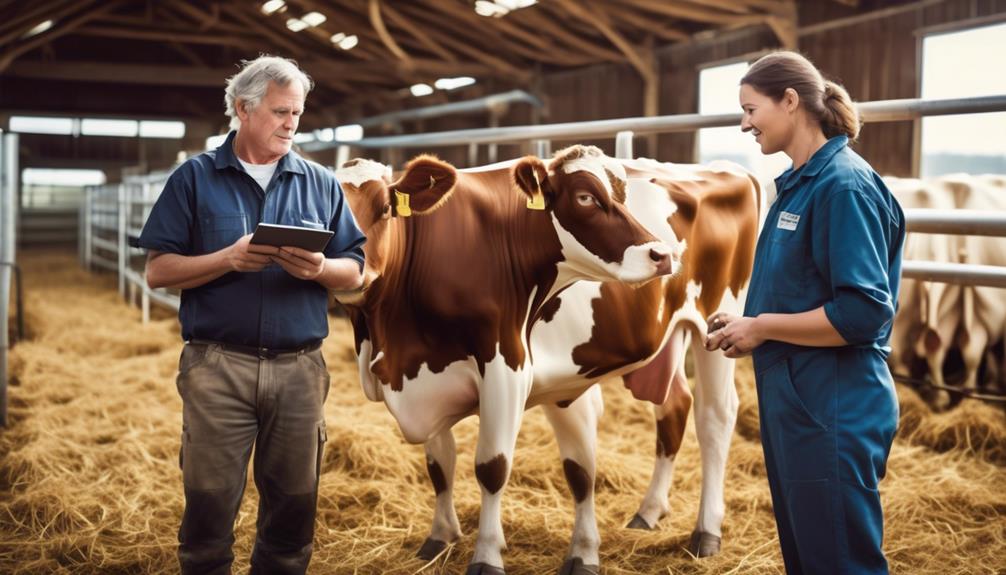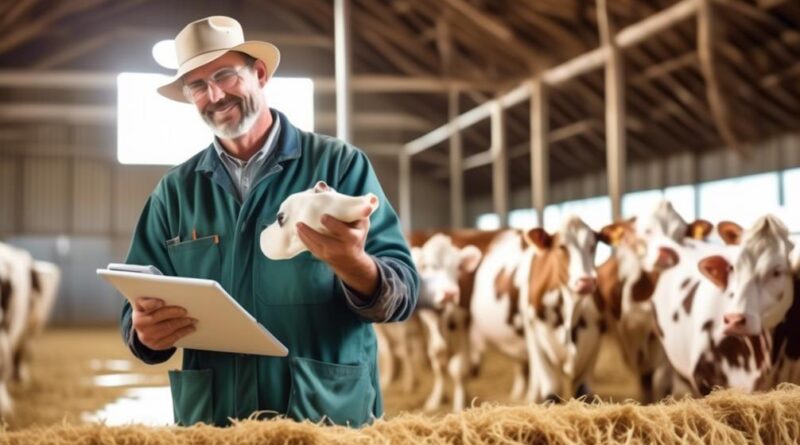3 Best Practices for Reducing Antibiotic Use in Dairy Herds
When it comes to reducing antibiotic use in dairy herds, you're navigating uncharted waters, but the journey is worthwhile.
You may already be aware of the importance of preserving the efficacy of antibiotics in animal agriculture, but you're curious about the specific strategies that can be implemented.
What if you could discover three practical and effective practices that not only minimize antibiotic use but also promote the overall health and well-being of your dairy herd?
You're about to uncover the key principles that can revolutionize the way you manage your herd's health.
Antibiotic Stewardship in Dairy Farms
To reduce antibiotic use in dairy herds, implement antibiotic stewardship practices to ensure responsible and effective treatment of livestock. Antibiotic stewardship is vital in combating antibiotic resistance and promoting responsible medication usage on dairy farms. It involves carefully managing antibiotic administration, monitoring their effectiveness, and minimizing their unnecessary use.
As a dairy farmer, you play a crucial role in implementing antibiotic stewardship practices on your farm. Start by working closely with a veterinarian to develop a comprehensive treatment plan tailored to your herd's specific needs. By doing so, you can ensure that antibiotics are only used when necessary and are the most effective choice for combating illnesses.
Furthermore, it's important to keep detailed records of antibiotic usage and treatment outcomes. This will allow you to track the effectiveness of different antibiotics, identify any patterns of resistance, and make informed decisions about future treatment plans. By monitoring and analyzing this data, you can optimize your medication practices and minimize the development of antibiotic-resistant bacteria in your herd.
In addition to responsible medication usage, proper hygiene and preventive measures are also essential components of antibiotic stewardship. Maintaining clean living conditions, practicing good nutrition, and implementing vaccination programs can help reduce the need for antibiotics and promote overall herd health.
Preventive Health Management Strategies
Implement preventive health management strategies to proactively maintain the well-being of your dairy herd and minimize the reliance on antibiotics. Prioritizing herd health through preventive measures is crucial for reducing the need for antibiotic intervention and promoting sustainable dairy farming practices.
Here are some key strategies to consider:
- Regular Veterinary Consultations: Schedule routine check-ups with a qualified veterinarian to assess the overall health of your herd. These consultations can help identify potential health issues early on and enable the implementation of appropriate preventive measures.
- Nutritional Management: Ensure that your dairy herd receives a balanced and nutritious diet tailored to their specific nutritional requirements. Proper nutrition plays a significant role in maintaining the overall health and immunity of your herd, reducing the risk of diseases.
- Vaccination Protocols: Work closely with your veterinarian to establish and follow a comprehensive vaccination program for your dairy herd. Vaccinations are a vital preventive measure that can significantly reduce the incidence and severity of infectious diseases within the herd.
Enhanced Nutrition and Feeding Practices
Enhancing the nutritional content of your dairy herd's diet is pivotal for promoting their overall health and reducing the reliance on antibiotics. To achieve this, focus on feed quality and maintaining a nutritional balance in their diet.
High-quality feed ensures that your herd receives the necessary nutrients, which in turn strengthens their immune system and reduces the likelihood of infections. Additionally, a well-balanced diet supports the overall health and productivity of your dairy herd, minimizing the need for antibiotic interventions.
When it comes to feed quality, prioritize sourcing feeds that are free from mold, toxins, and contaminants, as these can compromise the health of your dairy herd. Ensuring the freshness and quality of the feed provided to your herd is essential for optimizing their nutrition and minimizing the risk of health issues that may necessitate antibiotic treatment.
Furthermore, maintaining a nutritional balance in the diet of your dairy herd is crucial. Work with a qualified nutritionist to develop a diet that meets the specific needs of your herd at different stages of life. A balanced diet not only supports overall health but also aids in preventing nutritional deficiencies that could weaken the immune system, making your herd more susceptible to infections.
Effective Disease Prevention Protocols
Explore proactive measures to safeguard the health of your dairy herd through effective disease prevention protocols.
Implementing vaccination schedules is crucial to protect your herd from common infectious diseases. Consult with your veterinarian to develop a comprehensive vaccination plan tailored to your herd's specific needs.
Additionally, consider implementing biosecurity measures to minimize the introduction and spread of pathogens. This can include protocols for visitors, equipment, and animal introductions to reduce the risk of disease transmission.
Conducting regular herd health evaluations is essential for early detection and management of potential health issues. Work closely with your veterinarian to establish a thorough monitoring program that includes regular check-ups and diagnostic testing.
Optimal Herd Hygiene Practices
To maintain the health and well-being of your dairy herd, ensuring optimal herd hygiene practices is essential for minimizing the risk of disease transmission and the need for antibiotic interventions. Two crucial aspects of herd hygiene are manure management and stall design.
Effective manure management is vital in reducing the risk of disease spread within your dairy herd. Proper manure handling, storage, and disposal are essential to prevent the buildup of pathogens and bacteria. Regular removal of manure from the barns and pens, as well as ensuring proper drainage to prevent pooling of manure, can significantly contribute to maintaining a clean and healthy environment for your herd.
Stall design also plays a significant role in herd hygiene. Comfortable and well-designed stalls not only contribute to the overall welfare of the dairy cows but also facilitate easier cleaning and maintenance. Properly designed stalls should allow for easy access for cleaning, provide adequate drainage to prevent moisture buildup, and minimize the likelihood of cows coming into contact with manure.
Incorporating these optimal herd hygiene practices into your daily herd management routines can help minimize the risk of disease and infections, ultimately reducing the need for antibiotic interventions. By maintaining a clean and hygienic environment through effective manure management and well-thought-out stall design, you can proactively contribute to the overall health and well-being of your dairy herd.
Regular Monitoring and Surveillance Programs
Regular monitoring and surveillance programs are essential for early detection of potential health issues in your dairy herd. By implementing these programs, you can proactively identify emerging health concerns and take timely intervention measures to prevent the spread of diseases and minimize the need for antibiotic use.
Here are some key components to consider for effective monitoring and surveillance:
- Data Analysis: Regularly collect and analyze data on milk production, somatic cell counts, and clinical mastitis cases to identify any unusual patterns or trends. Utilize this information to detect deviations from the norm, which could indicate underlying health issues in the herd.
- Trend Identification: Keep a close eye on the health trends within your dairy herd. By monitoring factors such as feed intake, body condition scores, and reproductive performance, you can spot any deviations from the expected trends, enabling you to intervene early and address potential health problems before they escalate.
- Early Detection, Intervention: Establish protocols for early detection of common diseases and health issues, such as lameness, respiratory infections, and metabolic disorders. Prompt intervention, be it through improved nutrition, housing conditions, or targeted treatments, can significantly reduce the need for antibiotics and help maintain the overall health of your herd.
Collaborative Veterinarian-Producer Partnerships

Developing strong collaborative partnerships between veterinarians and dairy producers is essential for promoting proactive herd health management and reducing the reliance on antibiotics. Effective veterinarian communication and producer engagement are crucial components of these partnerships. Open and clear communication channels between veterinarians and producers are necessary to ensure that herd health strategies are well-understood and implemented effectively.
Regular communication between the veterinarian and the producer allows for the exchange of information regarding the health status of the herd, potential disease challenges, and the effectiveness of current management practices. This communication also enables the veterinarian to provide timely advice on preventive measures and management strategies to maintain herd health without the excessive use of antibiotics.
Producer engagement in herd health management involves active participation in decision-making processes, implementation of recommended practices, and regular monitoring of herd health parameters. When producers are engaged in herd health management, they become proactive partners in the reduction of antibiotic use. This engagement can include regular health check-ups, monitoring of milk quality, and implementing biosecurity measures.
Continuous Training and Education Initiatives
Engage dairy herd personnel in ongoing training and education initiatives to enhance their understanding of proactive herd health management strategies and reduce reliance on antibiotics. Continuous training development and educational workshops are essential for keeping your team updated with the latest advancements in dairy herd health management. By investing in the continuous education of your personnel, you can empower them to make informed decisions that prioritize proactive health strategies over antibiotic use.
Here are some key tactics to consider for implementing effective training and education initiatives:
- Customized Training Programs: Tailor training programs to address specific needs and challenges faced by your dairy herd personnel. This can include modules on identifying early signs of common health issues, proper hygiene practices, and understanding the importance of vaccination protocols.
- Hands-On Workshops: Organize practical, hands-on workshops that allow personnel to apply their knowledge in real-life scenarios. These workshops can cover topics such as proper administration of medication, recognizing signs of illness, and maintaining a clean and healthy environment for the herd.
- Access to Educational Resources: Provide access to educational resources such as webinars, online courses, and informational materials to ensure that your personnel have continuous opportunities for learning and skill development.
Frequently Asked Questions
What Are the Potential Legal and Regulatory Implications for Dairy Farms That Do Not Reduce Antibiotic Use?
If you don't reduce antibiotic use, there may be legal implications and challenges with regulatory compliance. Failing to do so could result in fines, legal action, and difficulties in meeting industry standards and expectations.
How Can Dairy Farms Ensure the Welfare and Comfort of Their Cows Without Relying on Antibiotics?
To ensure the welfare and comfort of your cows without relying on antibiotics, focus on proactive herd health management and explore alternative treatments. Implementing best practices will support their well-being and minimize the need for antibiotics.
Are There Alternative Treatments or Therapies That Can Be Used in Place of Antibiotics for Common Dairy Herd Health Issues?
You can explore alternative therapies like herbal remedies, probiotic supplements, and homeopathic treatments. These holistic approaches provide options for common dairy herd health issues, reducing reliance on antibiotics and promoting overall herd well-being.
How Can Dairy Farms Communicate Their Antibiotic Reduction Efforts to Consumers and the Public?
When communicating your antibiotic reduction efforts to consumers, be transparent. Show them how you prioritize animal welfare and public health. Address public concerns, educate about your practices, and demonstrate your commitment to responsible dairy farming.
What Are the Potential Economic Benefits for Dairy Farms That Successfully Reduce Antibiotic Use in Their Herds?
You'll see economic benefits when successfully reducing antibiotic use in your dairy herd. Improved herd health leads to lower vet bills, increased productivity, and higher-quality milk. Plus, it can enhance your farm's reputation with consumers.
Conclusion
In conclusion, by implementing preventive health management strategies, enhanced nutrition and feeding practices, and effective disease prevention protocols, you can reduce antibiotic use in your dairy herd.
Optimal herd hygiene, regular monitoring, collaborative partnerships with your veterinarian, and continuous training and education are crucial for successful antibiotic stewardship.
By following these best practices, you can contribute to the responsible use of antibiotics and promote the health and well-being of your herd.
